display Alfa Romeo GT 2006 Owner handbook (in English)
[x] Cancel search | Manufacturer: ALFA ROMEO, Model Year: 2006, Model line: GT, Model: Alfa Romeo GT 2006Pages: 307, PDF Size: 6.05 MB
Page 127 of 307
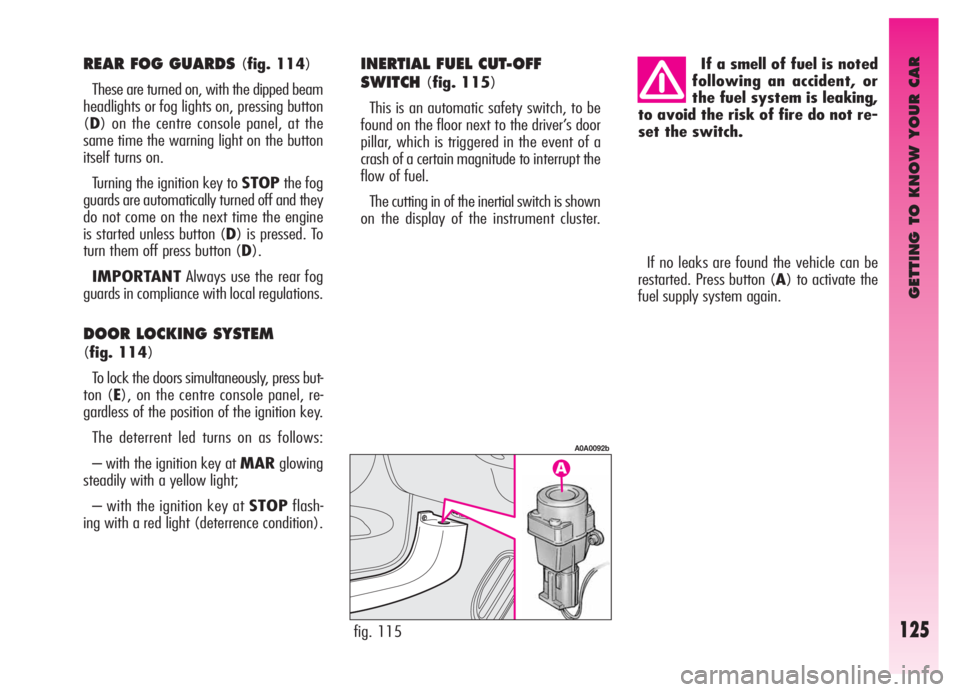
GETTING TO KNOW YOUR CAR
125
If no leaks are found the vehicle can be
restarted. Press button (A) to activate the
fuel supply system again.
fig. 115
A0A0092b
If a smell of fuel is noted
following an accident, or
the fuel system is leaking,
to avoid the risk of fire do not re-
set the switch.REAR FOG GUARDS (fig. 114)
These are turned on, with the dipped beam
headlights or fog lights on, pressing button
(D) on the centre console panel, at the
same time the warning light on the button
itself turns on.
Turning the ignition key to STOPthe fog
guards are automatically turned off and they
do not come on the next time the engine
is started unless button (D) is pressed. To
turn them off press button (D).
IMPORTANTAlways use the rear fog
guards in compliance with local regulations.
DOOR LOCKING SYSTEM
(fig. 114)
To lock the doors simultaneously, press but-
ton (E), on the centre console panel, re-
gardless of the position of the ignition key.
The deterrent led turns on as follows:
– with the ignition key at MARglowing
steadily with a yellow light;
– with the ignition key at STOPflash-
ing with a red light (deterrence condition).
INERTIAL FUEL CUT-OFF
SWITCH
(fig. 115)
This is an automatic safety switch, to be
found on the floor next to the driver’s door
pillar, which is triggered in the event of a
crash of a certain magnitude to interrupt the
flow of fuel.
The cutting in of the inertial switch is shown
on the display of the instrument cluster.
Page 128 of 307

GETTING TO KNOW YOUR CAR
126
The adjustment of Xenon headlights is au-
tomatic, therefore the versions fitted with
this optional lack the headlight aiming de-
vice (fig. 116a).
HAND BRAKE(fig. 117)
The hand brake lever is located between
the two front seats.
To operate the brake when the vehicle is
stationary, pull lever (A) upwards, until the
required braking action is obtained.
When the ignition key is at MAR, the
warning light on the instrument cluster
x
will come on.
fig. 117
A0A0620b
fig. 116a versions with Xenon headlights
A0A0677b
Adjust the beams every
time the load carried
changes.
For correct adjustment, bear in mind the
following conditions:
– position 0: one or two people occupy-
ing the the front seats
– position 1: five people;
– position 2: five people + load in the
boot;
– position 3: driver + maximum permis-
sible load all stowed in lug-
gage compartment
fig. 116 versions without Xenon headlights
A0A0093b
HEADLIGHT AIMING DEVICE
(fig. 116)
The headlights should be aimed correctly
depending on the vehicle load.
To do this, use the rocker button (A), on
the plate at the side of the steering column:
– press the arrow on the button (
A), to
increase by one position (e.g.:0
➟1➟2➟
3);
– press the arrow on the button (
S), to lower
by one position (e.g.:3
➟2➟1➟0);
The display (B) in the tachometer shows the
positions during adjustment.
Page 130 of 307
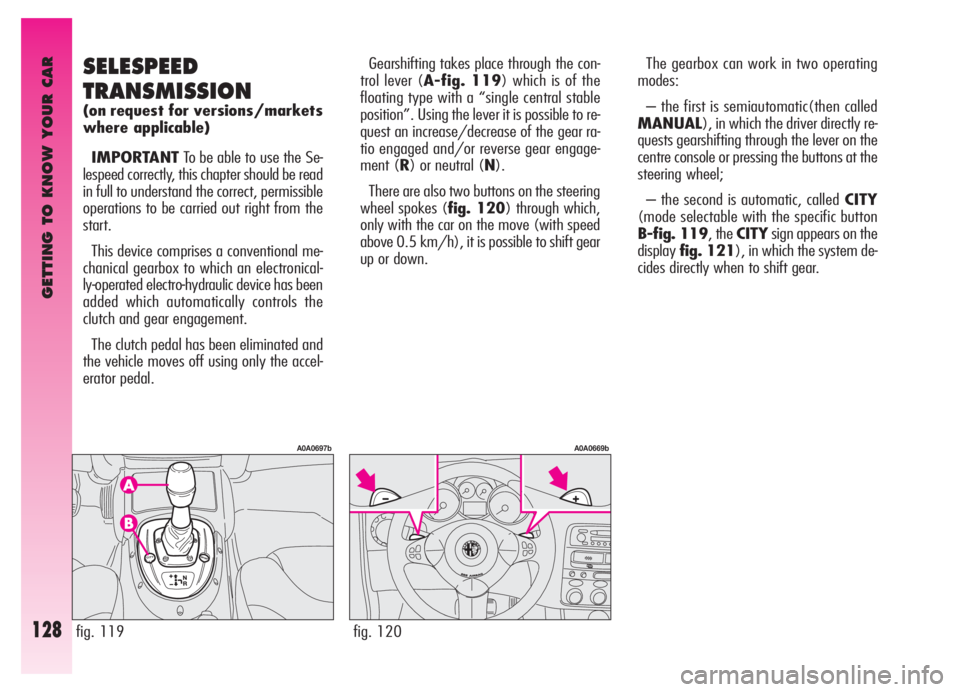
GETTING TO KNOW YOUR CAR
128
The gearbox can work in two operating
modes:
– the first is semiautomatic(then called
MANUAL), in which the driver directly re-
quests gearshifting through the lever on the
centre console or pressing the buttons at the
steering wheel;
– the second is automatic, calledCITY
(mode selectable with the specific button
B-fig. 119, the CITYsign appears on the
displayfig. 121), in which the system de-
cides directly when to shift gear.SELESPEED
TRANSMISSION
(on request for versions/markets
where applicable)
IMPORTANTTo be able to use the Se-
lespeed correctly, this chapter should be read
in full to understand the correct, permissible
operations to be carried out right from the
start.
This device comprises a conventional me-
chanical gearbox to which an electronical-
ly-operated electro-hydraulic device has been
added which automatically controls the
clutch and gear engagement.
The clutch pedal has been eliminated and
the vehicle moves off using only the accel-
erator pedal.Gearshifting takes place through the con-
trol lever (A-fig. 119) which is of the
floating type with a “single central stable
position”. Using the lever it is possible to re-
quest an increase/decrease of the gear ra-
tio engaged and/or reverse gear engage-
ment (R) or neutral (N).
There are also two buttons on the steering
wheel spokes (fig. 120) through which,
only with the car on the move (with speed
above 0.5 km/h), it is possible to shift gear
up or down.
fig. 119
A0A0697b
fig. 120
A0A0669b
Page 131 of 307
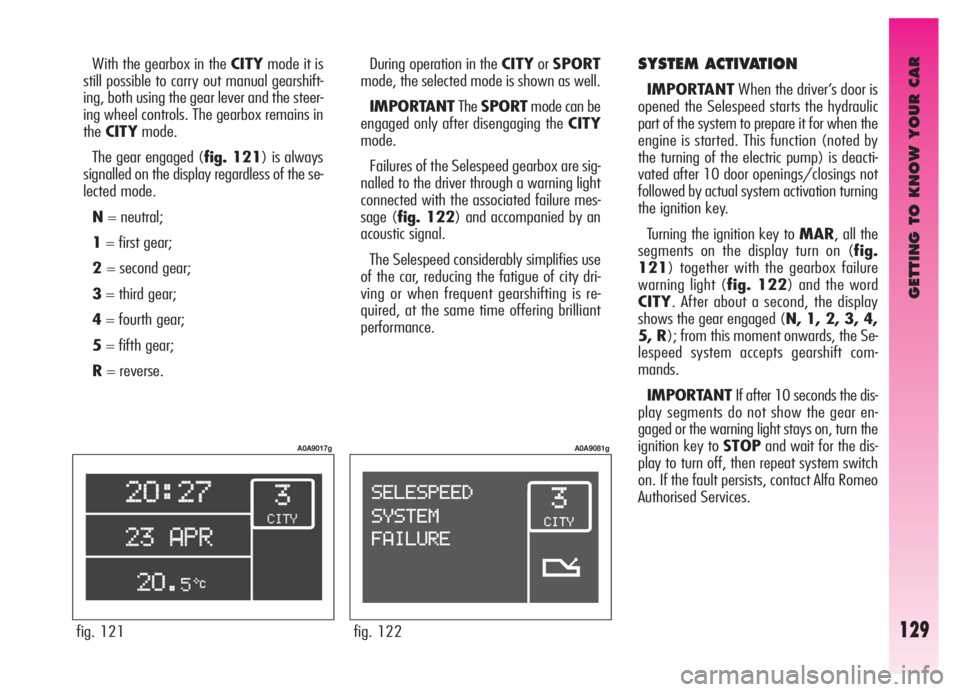
GETTING TO KNOW YOUR CAR
129
SYSTEM ACTIVATION
IMPORTANTWhen the driver’s door is
opened the Selespeed starts the hydraulic
part of the system to prepare it for when the
engine is started. This function (noted by
the turning of the electric pump) is deacti-
vated after 10 door openings/closings not
followed by actual system activation turning
the ignition key.
Turning the ignition key to MAR, all the
segments on the display turn on (fig.
121) together with the gearbox failure
warning light (fig. 122) and the word
CITY. After about a second, the display
shows the gear engaged (N, 1, 2, 3, 4,
5, R); from this moment onwards, the Se-
lespeed system accepts gearshift com-
mands.
IMPORTANTIf after 10 seconds the dis-
play segments do not show the gear en-
gaged or the warning light stays on, turn the
ignition key to STOPand wait for the dis-
play to turn off, then repeat system switch
on. If the fault persists, contact Alfa Romeo
Authorised Services. With the gearbox in the CITYmode it is
still possible to carry out manual gearshift-
ing, both using the gear lever and the steer-
ing wheel controls. The gearbox remains in
theCITYmode.
The gear engaged (fig. 121) is always
signalled on the display regardless of the se-
lected mode.
N= neutral;
1= first gear;
2= second gear;
3= third gear;
4= fourth gear;
5= fifth gear;
R= reverse.During operation in the CITYorSPORT
mode, the selected mode is shown as well.
IMPORTANTTheSPORTmode can be
engaged only after disengaging the CITY
mode.
Failures of the Selespeed gearbox are sig-
nalled to the driver through a warning light
connected with the associated failure mes-
sage (fig. 122) and accompanied by an
acoustic signal.
The Selespeed considerably simplifies use
of the car, reducing the fatigue of city dri-
ving or when frequent gearshifting is re-
quired, at the same time offering brilliant
performance.
fig. 121
A0A9017g
fig. 122
A0A9081g
Page 132 of 307
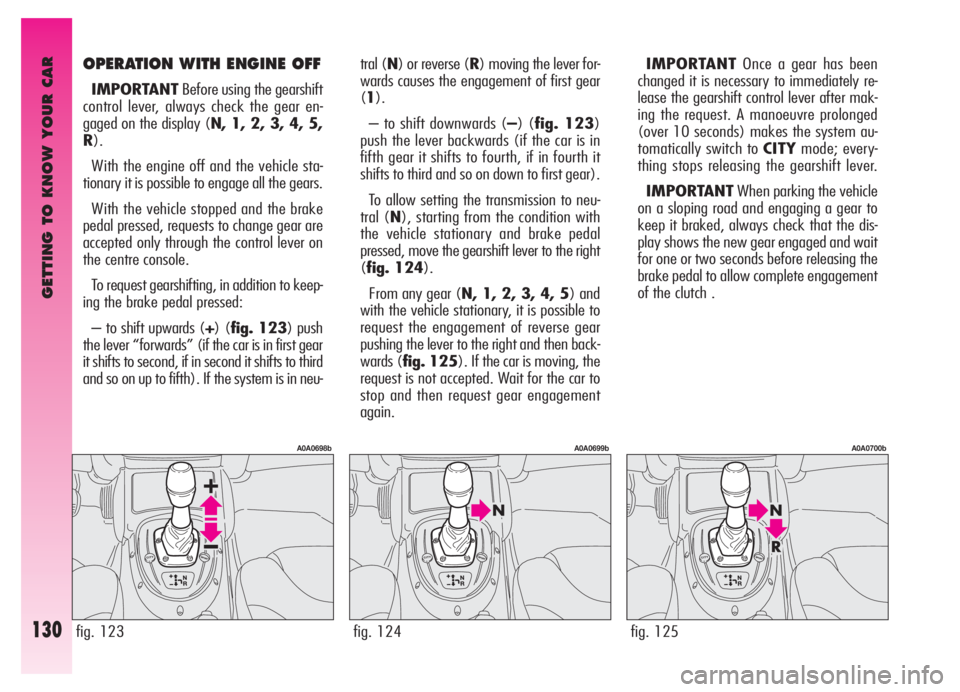
GETTING TO KNOW YOUR CAR
130
IMPORTANTOnce a gear has been
changed it is necessary to immediately re-
lease the gearshift control lever after mak-
ing the request. A manoeuvre prolonged
(over 10 seconds) makes the system au-
tomatically switch to CITYmode; every-
thing stops releasing the gearshift lever.
IMPORTANTWhen parking the vehicle
on a sloping road and engaging a gear to
keep it braked, always check that the dis-
play shows the new gear engaged and wait
for one or two seconds before releasing the
brake pedal to allow complete engagement
of the clutch .
fig. 125
A0A0700b
OPERATION WITH ENGINE OFF
IMPORTANTBefore using the gearshift
control lever, always check the gear en-
gaged on the display (N, 1, 2, 3, 4, 5,
R).
With the engine off and the vehicle sta-
tionary it is possible to engage all the gears.
With the vehicle stopped and the brake
pedal pressed, requests to change gear are
accepted only through the control lever on
the centre console.
To request gearshifting, in addition to keep-
ing the brake pedal pressed:
– to shift upwards (+) (fig. 123) push
the lever “forwards” (if the car is in first gear
it shifts to second, if in second it shifts to third
and so on up to fifth). If the system is in neu-tral (N) or reverse (R) moving the lever for-
wards causes the engagement of first gear
(1).
– to shift downwards (–) (fig. 123)
push the lever backwards (if the car is in
fifth gear it shifts to fourth, if in fourth it
shifts to third and so on down to first gear).
To allow setting the transmission to neu-
tral (N), starting from the condition with
the vehicle stationary and brake pedal
pressed, move the gearshift lever to the right
(fig. 124).
From any gear (N, 1, 2, 3, 4, 5) and
with the vehicle stationary, it is possible to
request the engagement of reverse gear
pushing the lever to the right and then back-
wards (fig. 125). If the car is moving, the
request is not accepted. Wait for the car to
stop and then request gear engagement
again.
fig. 123
A0A0698b
fig. 124
A0A0699b
Page 133 of 307
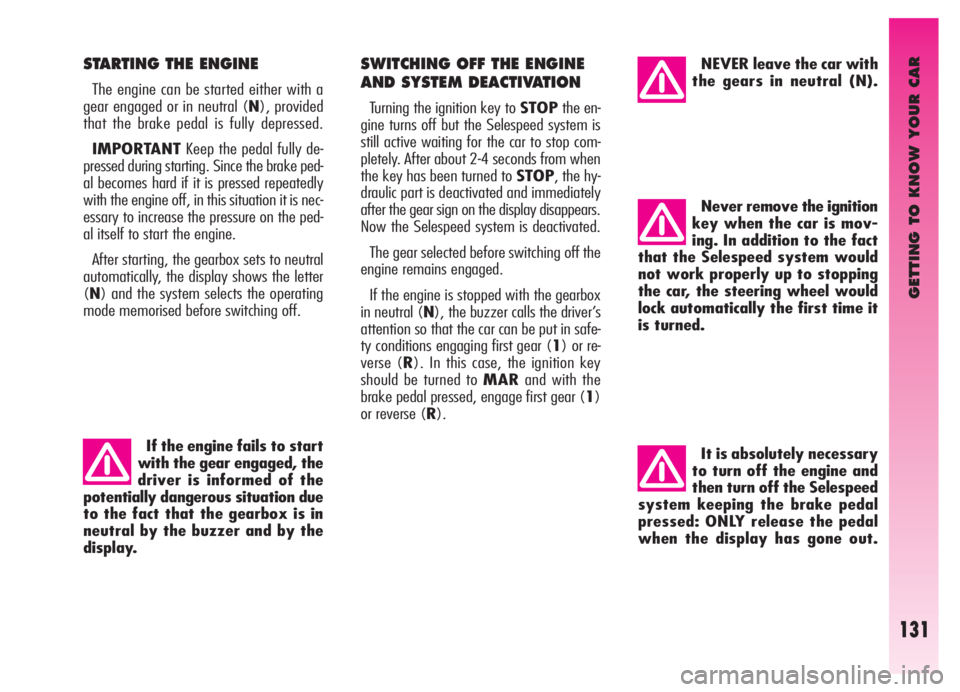
GETTING TO KNOW YOUR CAR
131
Never remove the ignition
key when the car is mov-
ing. In addition to the fact
that the Selespeed system would
not work properly up to stopping
the car, the steering wheel would
lock automatically the first time it
is turned.
STARTING THE ENGINE
The engine can be started either with a
gear engaged or in neutral (N), provided
that the brake pedal is fully depressed.
IMPORTANTKeep the pedal fully de-
pressed during starting. Since the brake ped-
al becomes hard if it is pressed repeatedly
with the engine off, in this situation it is nec-
essary to increase the pressure on the ped-
al itself to start the engine.
After starting, the gearbox sets to neutral
automatically, the display shows the letter
(N) and the system selects the operating
mode memorised before switching off.
If the engine fails to start
with the gear engaged, the
driver is informed of the
potentially dangerous situation due
to the fact that the gearbox is in
neutral by the buzzer and by the
display.
SWITCHING OFF THE ENGINE
AND SYSTEM DEACTIVATION
Turning the ignition key to STOPthe en-
gine turns off but the Selespeed system is
still active waiting for the car to stop com-
pletely. After about 2-4 seconds from when
the key has been turned to STOP, the hy-
draulic part is deactivated and immediately
after the gear sign on the display disappears.
Now the Selespeed system is deactivated.
The gear selected before switching off the
engine remains engaged.
If the engine is stopped with the gearbox
in neutral (N), the buzzer calls the driver’s
attention so that the car can be put in safe-
ty conditions engaging first gear (1) or re-
verse (R). In this case, the ignition key
should be turned to MARand with the
brake pedal pressed, engage first gear (1)
or reverse (R).
NEVER leave the car with
the gears in neutral (N).
It is absolutely necessary
to turn off the engine and
then turn off the Selespeed
system keeping the brake pedal
pressed: ONLY release the pedal
when the display has gone out.
Page 134 of 307

GETTING TO KNOW YOUR CAR
132
This should not be considered a failure be-
cause it is part of the operating logic. For
the same reason, if sticking occurs on re-
verse gear, the system controls partial clutch
closing so that the gear can be engaged;
in this case the engagement of reverse gear
(R) will not be as smooth as usual.
Moving off the car is obtained:
1) releasing the brake pedal;
2) gradually pressing the accelerator pedal.
The more the accelerator is pressed the
higher the pickup torque.
After a request to shift
gear with the car station-
ary, before pressing the ac-
celerator pedal to make the car
move, the driver must always
check the display to see that the
gear engaged is the one required.MOVING OFF THE CAR
With the engine on and the car stationary,
the gears that can be engaged for moving
off are only first (1), second (2) or reverse
(R).
To engage them, keep the brake pedal de-
pressed and operate only the control lever
on the central console, as the steering wheel
levers make it possible to engage the gears
only at speed over 0.5 km/h.
IMPORTANTReverse gear (R) can be
engaged from any of the following other ra-
tios: neutral (N), first (1) or second (2).
If the car is moving, the request is not ac-
cepted, it is necessary to wait for the car
to stop completely and request the en-
gagement of reverse again (R).
The driver is informed of the reverse gear
engaged condition by the display and by the
intermittent sound of a buzzer.
IMPORTANTIf when shifting from re-
verse (R)/first (1) or neutral (N)/first (1)
sticking occurs on first gear, the system au-
tomatically engages second gear (2).IMPORTANTS
– With the car stopped and a gear en-
gaged always keep the brake pedal pressed
until deciding to move off;
– during prolonged halts with the engine
running it is advisable to keep the gearbox
in neutral;
– when the car is parked facing uphill, do
not use the moving off manoeuvre to keep
the car still; use the brake pedal and press
the accelerator pedal only when deciding to
move off;
– use second gear only when more con-
trol is needed for moving off manoeuvres at
low speed;
– if, in reverse gear, first gear is engaged
or vice versa, shift gear only when the car
is stopped completely and with the brake
pedal pressed.
Though highly unadvisable, if when trav-
elling downhill for some unexpected reason
the car is set to neutral (N), when the en-
gagement of a gear is requested the system
automatically engages the best gear in re-
lation to the speed of the car to allow the
correct transmission of torque to the wheels.
Page 135 of 307
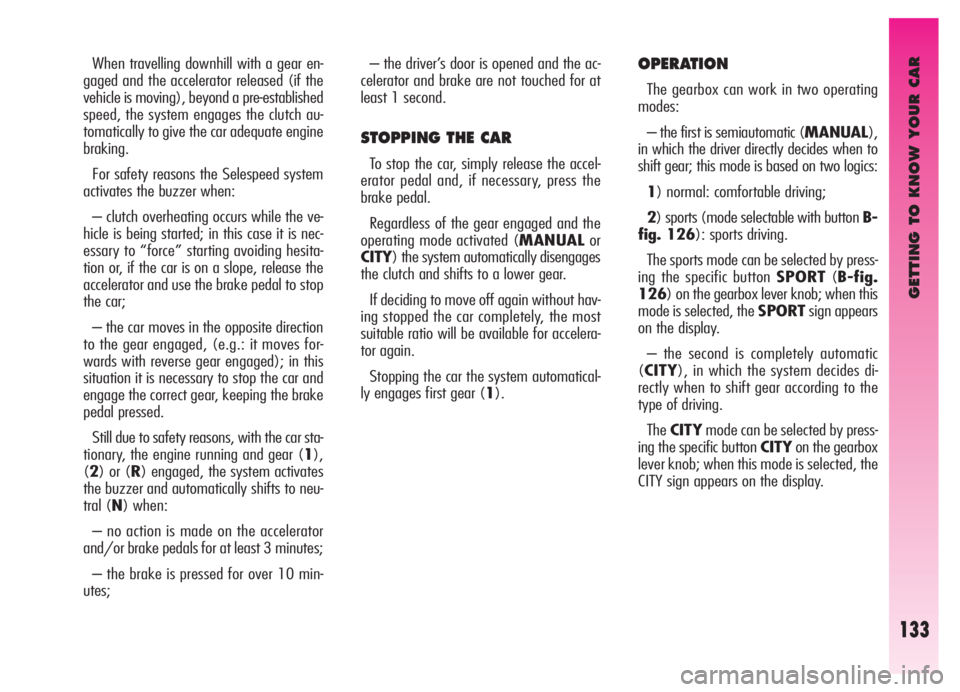
GETTING TO KNOW YOUR CAR
133
OPERATION
The gearbox can work in two operating
modes:
– the first is semiautomatic (MANUAL),
in which the driver directly decides when to
shift gear; this mode is based on two logics:
1) normal: comfortable driving;
2) sports (mode selectable with button B-
fig. 126): sports driving.
The sports mode can be selected by press-
ing the specific button SPORT(B-fig.
126) on the gearbox lever knob; when this
mode is selected, the SPORTsign appears
on the display.
– the second is completely automatic
(CITY), in which the system decides di-
rectly when to shift gear according to the
type of driving.
TheCITYmode can be selected by press-
ing the specific button CITYon the gearbox
lever knob; when this mode is selected, the
CITY sign appears on the display. When travelling downhill with a gear en-
gaged and the accelerator released (if the
vehicle is moving), beyond a pre-established
speed, the system engages the clutch au-
tomatically to give the car adequate engine
braking.
For safety reasons the Selespeed system
activates the buzzer when:
– clutch overheating occurs while the ve-
hicle is being started; in this case it is nec-
essary to “force” starting avoiding hesita-
tion or, if the car is on a slope, release the
accelerator and use the brake pedal to stop
the car;
– the car moves in the opposite direction
to the gear engaged, (e.g.: it moves for-
wards with reverse gear engaged); in this
situation it is necessary to stop the car and
engage the correct gear, keeping the brake
pedal pressed.
Still due to safety reasons, with the car sta-
tionary, the engine running and gear (1),
(2) or (R) engaged, the system activates
the buzzer and automatically shifts to neu-
tral (N) when:
– no action is made on the accelerator
and/or brake pedals for at least 3 minutes;
– the brake is pressed for over 10 min-
utes;– the driver’s door is opened and the ac-
celerator and brake are not touched for at
least 1 second.
STOPPING THE CAR
To stop the car, simply release the accel-
erator pedal and, if necessary, press the
brake pedal.
Regardless of the gear engaged and the
operating mode activated (MANUALor
CITY) the system automatically disengages
the clutch and shifts to a lower gear.
If deciding to move off again without hav-
ing stopped the car completely, the most
suitable ratio will be available for accelera-
tor again.
Stopping the car the system automatical-
ly engages first gear (1).
Page 137 of 307

GETTING TO KNOW YOUR CAR
135
With the accelerator pedal pressed to over
60% of its stroke and an engine speed
above 5000 rpm, gearshifting becomes
quicker. In the MANUALoperating mode
there are certain automatic/security devices
which simplify driving:
– At slowing down the clutch is disen-
gaged and the automatic reduction of the
gearbox ratio is carried out to be ready for
the possible gear recovery; on the contrary,
when the vehicle stops the gearbox will au-
tomatically engage the first gear (1);
– requests to change gear that would take
the engine to above maximum speed or be-
low minimum speed are not accepted;AUTOMATIC OPERATION (CITY)
The automatic operating mode CITYis se-
lected pressing button (A-fig. 128), at
the base of the gearshift lever or activating
the Cruise Control system (where fitted).
In addition to the gear, the display shows
the word CITY.
The system decides directly when gearshift-
ing according to the engine running speed
and the driving style.
Releasing the accelerator pedal quickly, the
system does not engage a higher gear in or-
der to maintain an adequate level of engine
brake.
fig. 128
A0A0701b
– if jamming occurs during gear engage-
ment, the system firstly tries to engage the
gear required again and, if it is still not pos-
sible, it automatically engages the imme-
diately higher one to avoid leaving the car
in neutral.
IMPORTANTIt is advisable to wait for
the end of a gear shifting operation before
requesting another one, to avoid multiple
requests in rapid succession.
Page 138 of 307
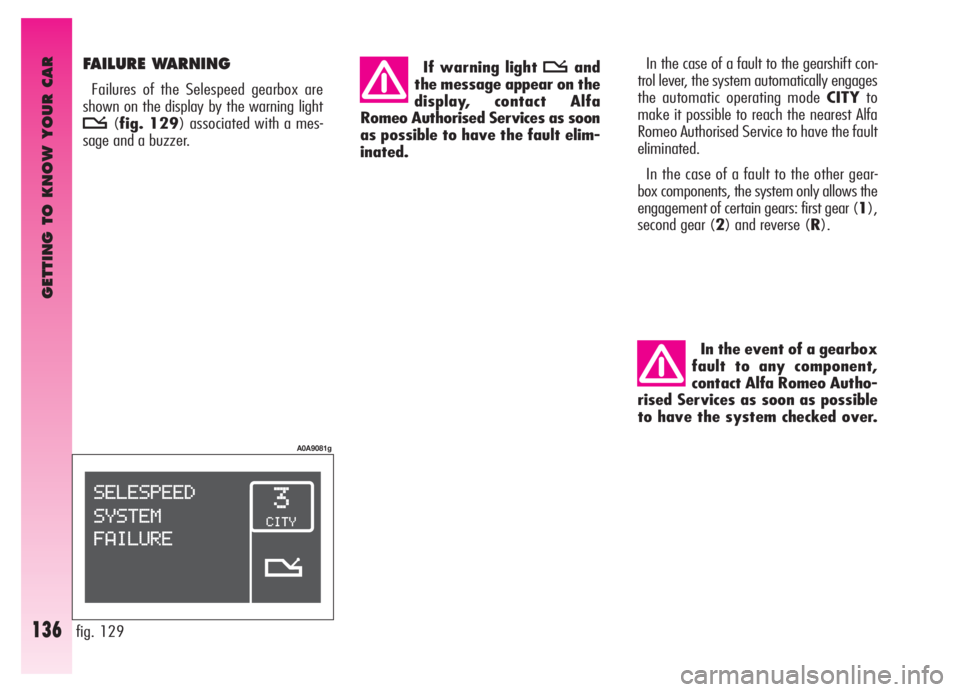
In the event of a gearbox
fault to any component,
contact Alfa Romeo Autho-
rised Services as soon as possible
to have the system checked over.In the case of a fault to the gearshift con-
trol lever, the system automatically engages
the automatic operating mode CITYto
make it possible to reach the nearest Alfa
Romeo Authorised Service to have the fault
eliminated.
In the case of a fault to the other gear-
box components, the system only allows the
engagement of certain gears: first gear (1),
second gear (2) and reverse (R).
GETTING TO KNOW YOUR CAR
136
FAILURE WARNING
Failures of the Selespeed gearbox are
shown on the display by the warning light
t(fig. 129) associated with a mes-
sage and a buzzer. If warning light
tand
the message appear on the
display, contact Alfa
Romeo Authorised Services as soon
as possible to have the fault elim-
inated.
fig. 129
A0A9081g